Acer Aspire 5 review: A likeable old-school 15.6in notebook
Discrete graphics, good connectivity, and a low price make the Aspire 5 a good general-purpose laptop
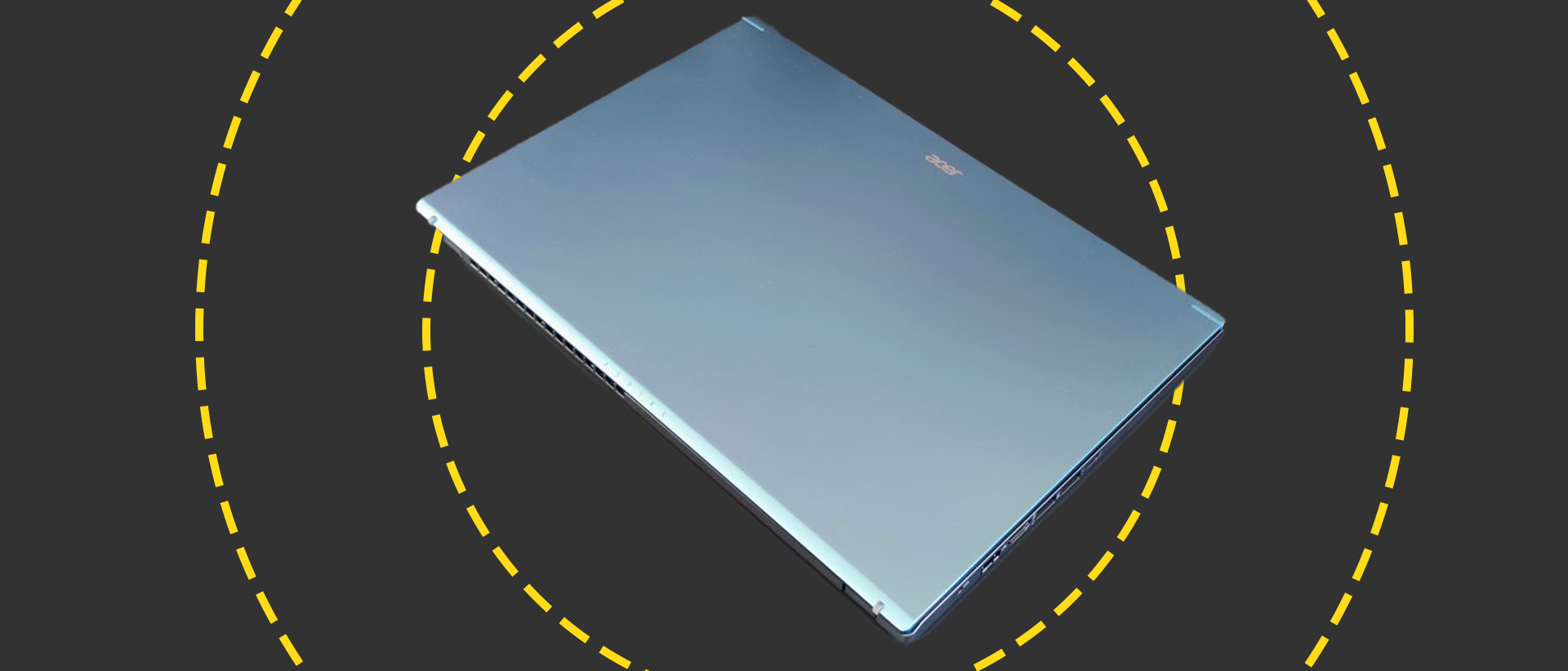
-
+
Great performance with discrete GPU
-
+
Wide selection of ports
-
+
Good value
-
-
Mediocre battery life
-
-
Screen is dull and drab
-
-
Keyboard is a bit bouncy

The Acer Aspire 5 is a general-purpose laptop with an old-school appeal and an attractive price. It is for the worker that wants a moderately powerful laptop and an expansive array of connectivity options, but one that is not filled with flashy extras.
Recent updates
Editors note At the time of the Original review, the Acer Aspire 5 was perhaps a little too expensive. But that has dropped, quite significantly, over the last two years making this a better offering as a whole. This isn't a premium model, but it is a dependable workstation with Thunderbolt 4 connections and Wi-Fi 6E. It might be dated with lots of AI-PCs now coming out at almost entry-level prices, but for small businesses that need solid work machines, or even reliable back ones, you can't go far wrong with the Acer Aspire 5.
Original article published: December 2022
The Acer Aspire 5 isn't a premium laptop, by any stretch of the imagination. No, it is, in fact, a brilliant budget option, perfect for smaller businesses or temporary workers. It has that old-school appeal that only really works due to its low price.
This is functionality over frilly extras -- there are no NPU chips or Copilot buttons here. But this is a sub-£500 machine that your workers can rely on for the average working day.
Acer Aspire 5 review: Design
Considering its rather low position in the Acer laptop hierarchy the Aspire 5 is a smart-looking device. The metallic finish to the aquamarine lid and slate grey body lend a sense of style that is often lacking towards the bottom of the market. The illusion is slightly dented when you first see the screen bezels; at 14mm on top and bottom and 8mm on the sides, you couldn't even begin to describe the display as edge-to-edge even if it does occupy 81% of the overall footprint.
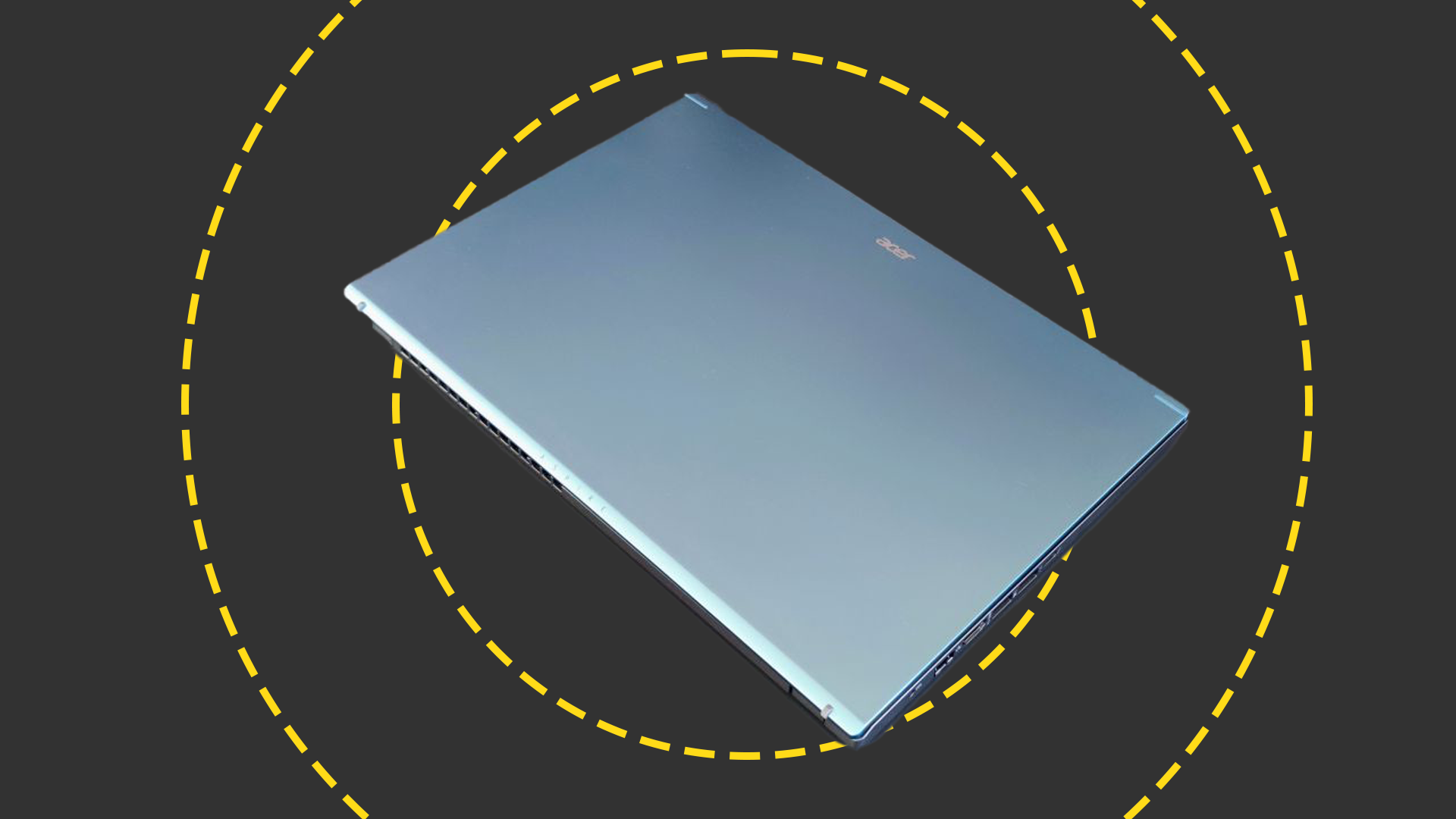
At 1.8Kg the Aspire is par for the course when it comes to weight for a 15.6in laptop and the same could be said of the exterior dimensions: 363 x 238 x 18mm is nothing out of the ordinary.
The only part of the Aspire 5 that's made from metal is the lid. Everything else is plastic but that's not quite as big an issue as you might suspect. Yes, the body of the Aspire 5 does flex a little and a little creaking can be heard if you give it a brutal twist but it is still a lot stiffer than some of the super-light laptops we've tested recently like the LG Gram 16. The average user will regard the Aspire 5 as perfectly well screwed together though the keyboard deck does experience some deformation if you push down hard in the middle around the Y/U and H/J keys.
Removing the base panel is a straightforward affair once you've removed the 10 Philips screws that hold it in place. Once inside you'll find two 2280 M.2 SSD bays, one (occupied) PCIe4 spec, and the other (empty) PCIe3 spec. You can also easily access the two SODIMM RAM mounts making it a cinch to upgrade from the standard 2 x 8GB to a maximum of 2 x 16GB. The battery and wireless card also look as though they'll come out without too much drama if they ever need upgrading or replacing.
Acer Aspire 5 review: Display
The Full HD 141dpi IPS display is the most mundane part of the Aspire 5. The maximum brightness is a lowly 228cd/m2 which rather precludes outdoor use nor is it particularly colorful registering only 62.4% of the sRGB color gamut and barely troubling the mid-40s for the Adobe RGB and DCI-P3 gamuts. The Delta E color variance was somewhat wayward too at 4.39, rather too far above the maximum ideal score of 3 for comfort. On the positive side, the contrast ratio is a very healthy 1451:1 and the viewing angles are usefully wide.
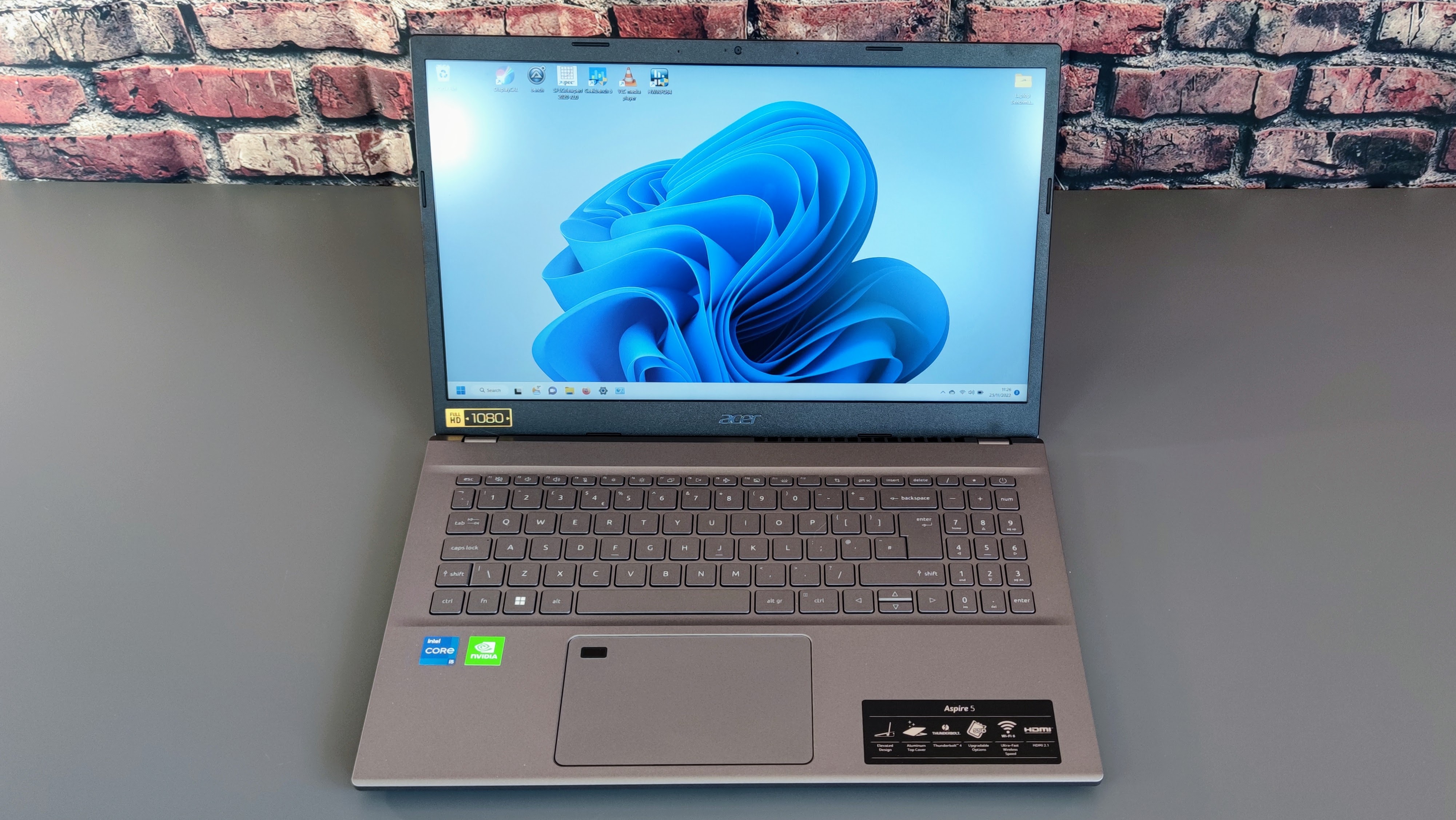
The display's rather basic specification is unlikely to impact general users but it will prove to be an issue if you want to do anything remotely creative. Images and video both look rather washed-out and flat when compared to better IPS let alone OLED displays. At least prolonged use won't damage your eyes thanks to Acer's BlueLightShield technology which limits the amount of blue light emitted to reduce eye strain.
Acer Aspire 5 review: Keyboard and touchpad
The keyboard has all the basics well covered. To start with there is a full numeric keypad which is always a boon for productivity and a backlight. Granted the backlight is a simple on/off affair but at this price point just having one isn't a given. There's nothing idiosyncratic about the layout with everything pretty much exactly where I expect it to be. If we had to be picky we'd mention that the keycap graphics are a little on the small side and the up/down cursor keys are half-height but that's it.
The typing action is nicely judged; the key travel is an unremarkable 1.5mm and the action is reasonably well-damped with no rattle, though the keys do feel just a little loose compared to other admittedly more expensive laptops we've tested recently. As has already been noted the keyboard deck isn't entirely solid but that never hindered our typing speed or enjoyment.
The touchpad measures 125 x 80mm which again is standard for a 15.6in laptop. The plastic surface is pleasant to the touch and the corner click-actions are precise and quiet. You lose some space to the fingerprint scanner but it doesn't impact usability one jot.
Acer Aspire 5 review: Specs and performance
This Aspire 5 (the exact Acer model designation is A515-57G) is built around a 10-core Intel Core i5-1235U CPU combined with 16GB of dual-channel DDR4 RAM. Unusually for a machine in this price category you get a discrete GPU, namely the Nvidia MX550 with 2GB of video RAM.
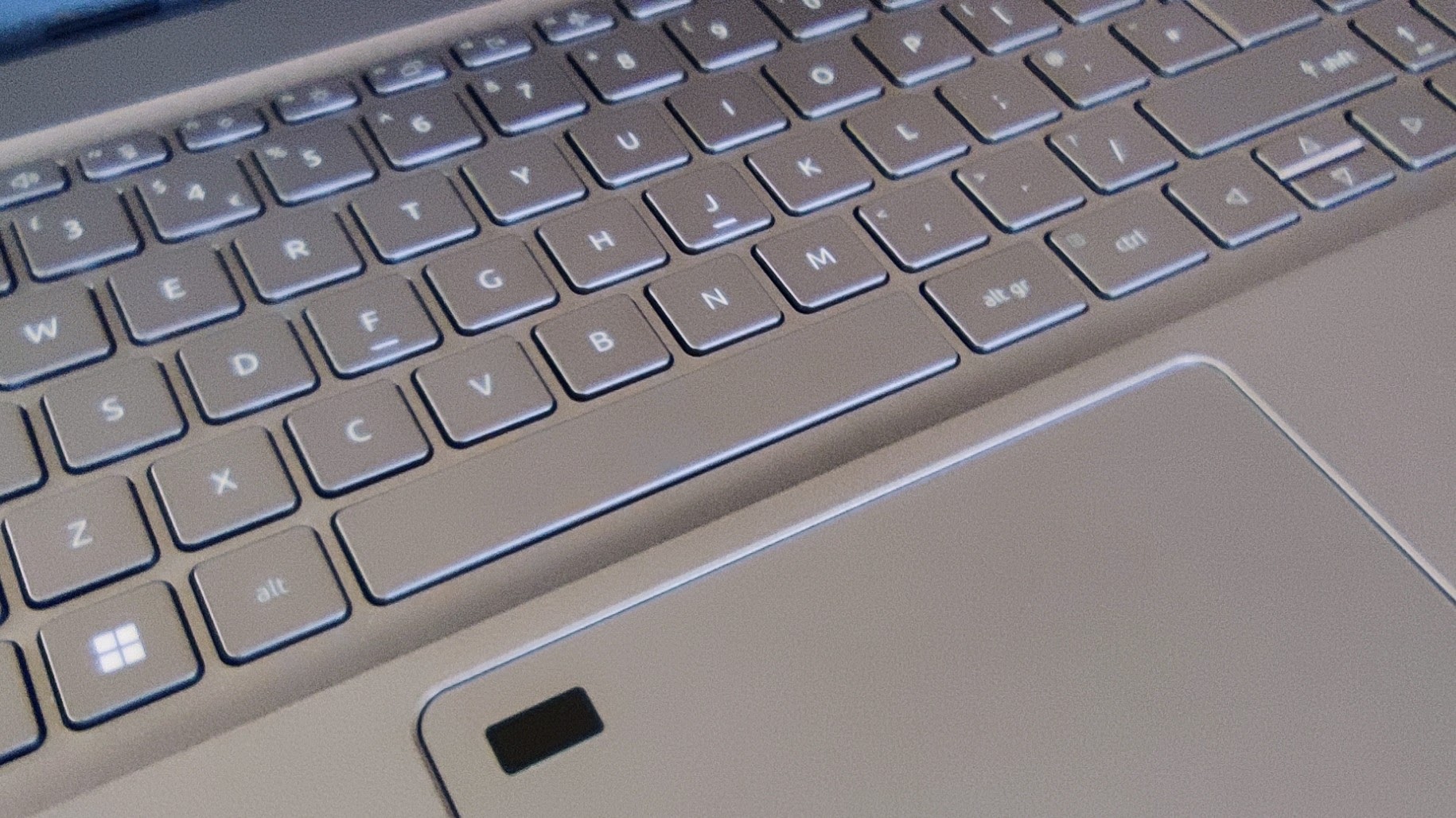
That combination returned a healthy 213 points in our 4K media benchmark which means the Aspire 5 has enough power to chew through even demanding productivity tasks without breaking into a sweat. The GeekBench 5 single and multi-core scores of 1,569 and 8,047 are right up with the sorts of scores we've seen from more powerful (and more expensive) chipsets like the Intel Core i7-1260P in the LG Gram 16 and Ryzen 5 Pro 6650U in the Lenovo ThinkPad Z13. Performance per ££ then really is an Aspire 5 main selling point.
The Nvidia MX550 GPU can't be described as a powerhouse and lacks gaming chops but it does offer a noticeable performance advantage over Intel's integrated Iris Xe graphics chip when it comes to photo and video editing or modelling. The SPECviewperf 3dsmax 3D modelling test ran at 21.6fs which may not sound like much but it is twice the speed you'd expect from this Intel chipset without a discrete GPU. The GeekBench OpenCL score of 37,488 was equally impressive for a machine built around a U-series i5 chip.
Acer Aspire 5 review: Battery life
With only a 50Wh battery we didn't expect great things from the Aspire and so it proved, a full charge lasting only 7hrs and 1min in our battery rundown test which involves looping a standard definition video in VLC with the display set to 170cd/m2 and in Airplane Mode. To be fair to Acer it doesn't claim any more than 7hrs from a charge. The Aspire 5 has three performance modes which can be cycled through using Fn+F. These don't have a huge impact on performance or duration; in 'Silent' mode, the battery life improved to 7hrs and 20min which is still nothing to write home about.
Acer Aspire 5 review: Ports and features
On the left side of the Aspire you'll find two Type-A 3.2 Gen 1 (5Gbits/sec) USB ports along with a Thunderbolt 4 spec Type-C port, an HDMI 2.1 video output and a drop-jaw Gigabit RJ45 Ethernet port. On the right is a third Type-A port along with the 3.5mm audio jack.
That's a very generous array by modern standards and before you complain about the single Type-C port you don't need to use it to charge because you also get a DC-in jack for the 65W charger, though you can use the Type-C to charge if you want to. It's a shame there is nothing in the way of a memory card reader especially as there is quite clearly enough room for one on the right-hand side.
The wireless card is a MediaTek MT7921 unit which supports 6GHz Wi-Fi 6E and Bluetooth 5.1. It works well enough but neither the I/O speed nor signal reception strength quite matched what we've seen from the likes of Intel's AX201 card.
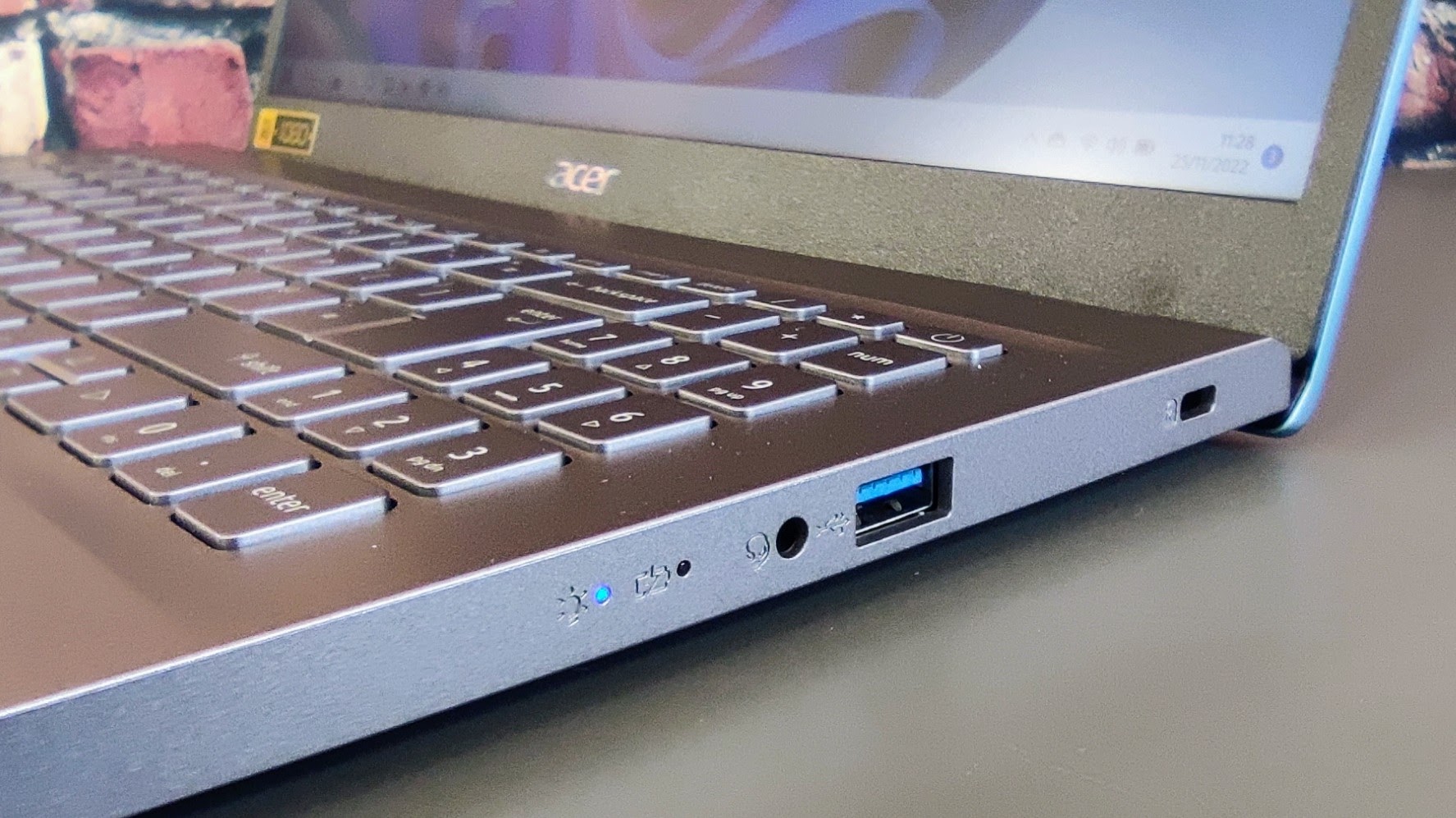
The 512GB Micron SSD performed rather better than expected recording average sequential read and write speeds of 3,080MB/s and 2,886MB/s respectively which is more than adequate for everyday use.
The webcam is a basic 720p affair that generates a slightly fuzzy video feed but it works well in low-light environments and there's surprisingly little over-exposure from rogue light sources like a low winter sun shining through your office window, a handy effect of Acer's TNR Solution image noise reduction tech. There's no support for Windows Hello IR facial recognition.
In terms of security, the Aspire 5 features a Trusted Platform Module and a Kensington lock slot while a reliable fingerprint reader allows for biometric log-in.
Acer Aspire 5 review: Is it worth it?
The answer to that question is a resounding yes because you can purchase the Aspire for as little as £380 on Amazon. A low-budget machine with all the basics - this is a great option.
The design is a little unimaginative, the keyboard has a bouncy feel, and the battery life is average. But what it does do, it does well. And there are a number of features that are surprising for this price range, such as the port selection, the Wi-Fi 6E connectivity, and the option to add a second SSD and or the Nvidia GPU -- plenty of choice here for upgrades.
Get the ITPro daily newsletter
Sign up today and you will receive a free copy of our Future Focus 2025 report - the leading guidance on AI, cybersecurity and other IT challenges as per 700+ senior executives
Over the years, Alun has written freelance for several online publications on subjects ranging from mobile phones to digital audio equipment and PCs and from electric cars to industrial heritage. Before becoming a technology writer, he worked at Sony Music for 15 years. Quite what either occupation has to do with the degree in Early Medieval History he read at the University of Leeds is a bit of a grey area. A native of Scotland but an adopted Mancunian, Alun divides his time between writing, listening to live music, dreaming of the glens and dealing with an unhinged Norwegian Elkhound. For ITPro, Alun reviews laptops and PCs from brands such as Acer, Asus, Lenovo, Dell and HP.
-
 Ransomware attacks are rising — but quiet payouts could mean there's more than actually reported
Ransomware attacks are rising — but quiet payouts could mean there's more than actually reportedNews Ransomware attacks continue to climb, but they may be even higher than official figures show as companies choose to quietly pay to make such incidents go away.
By Nicole Kobie Published
-
 Google tells some remote workers to return to the office or risk losing jobs
Google tells some remote workers to return to the office or risk losing jobsNews Google has warned remote workers will need to return to the office or else lose their jobs, according to reports.
By Ross Kelly Published
-
 IBM puts on a brave face as US government cuts hit 15 contracts
IBM puts on a brave face as US government cuts hit 15 contractsNews Despite the cuts, IBM remains upbeat after promising quarterly results
By Nicole Kobie Published